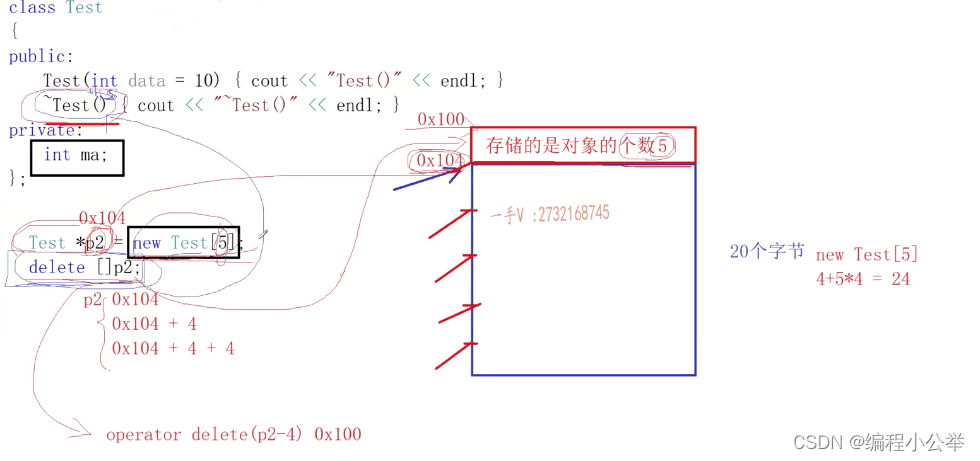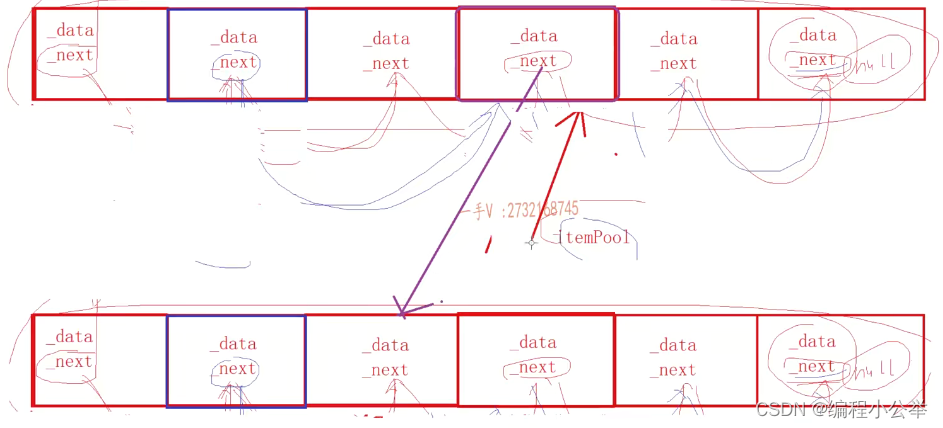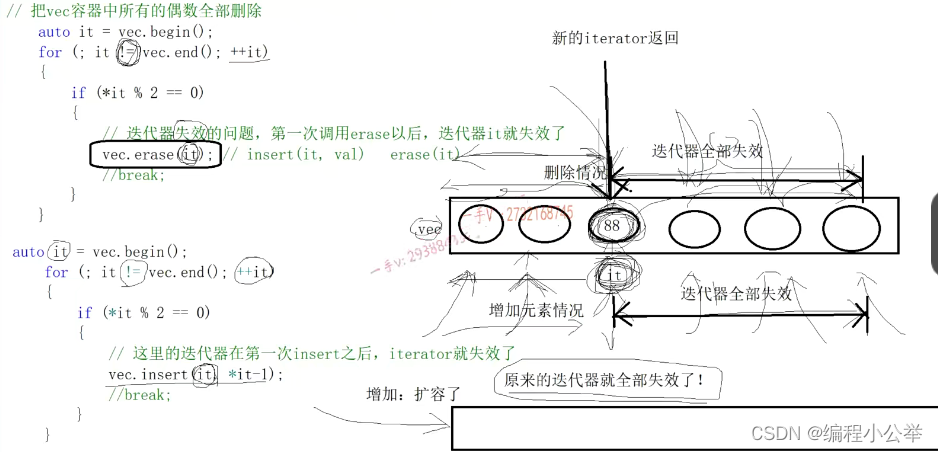1、深入理解new和delete原理
#include<iostream>
using namespace std;/*
new 和 delete
1、malloc和new的区别 new = 内存开辟+构造函数
2、free和 delete的区别 delete = 内存回收+析构函数
开辟失败malloc返nullptr ,new抛出bad_alloc异常new->operator new
delete ->operator delete
*///先调用operator new开辟内存空间然后调对象的构造函数
//void* operator new(size_t size)
//{
// void* p = malloc(size);
// if (p == nullptr)
// throw bad_alloc();
// cout << "operator new " << p << endl;
// return p;
//}
调用delete p;调用p指向对象的析构函数,在调用operator delete释放内存空间
//
//void operator delete(void* ptr)
//{
// cout << "operator delete " << ptr << endl;
//
// free(ptr);
//}//先调用operator new开辟内存空间然后调对象的构造函数/*
new和delete能混用吗? 为什么区分单个元素和数组的内存分配和释放呢?
new delete
new[] delete[]
对于普通的编译器内置类型new/delete[] new[]/delete可以混用自定义的类型有析构函数,为了正确调用,在开辟对象数组的时候会多开辟四个字节,记录对象的个数
*/
void* operator new[](size_t size){void* p = malloc(size);if (p == nullptr)throw bad_alloc();cout << "operator new addr[]" << p << endl;return p;}//调用delete p;调用p指向对象的析构函数,在调用operator delete释放内存空间void operator delete[](void* ptr){cout << "operator delete addr[]" << ptr << endl;free(ptr);}class Test{public:Test(int data = 10){cout << "Test()" << endl;}~Test(){cout << "~Test()" << endl;}};int main(){//try//{// int* p = new int;// delete p;// int* q = new int[10];// delete[]q;//}//catch (const bad_alloc& err)//{// cerr << err.what() << endl;//}//Test* p1 = new Test();//delete[]p1; //报错Test* p2 = new Test[5]; //delete p2;错误 Test[0]析构,直接俄free(p2)cout << "p2: " << p2 << endl;delete[]p2;return 0;}

2、new和delete重载对象池应用

#include<iostream>
using namespace std;/*运算符的重载:成员方法、全局方法
* 内存池 进程池 线程池 连接池 对象池
*/template<typename T>
class Queue
{
public:Queue(){_front = _rear = new QueueItem();}~Queue(){QueueItem* cur = _front;while (cur != nullptr){_front = _front->_next;delete cur;cur = _front;}}void push(const T& val){QueueItem* item = new QueueItem(val);_rear->_next = item;_rear = item;}void pop(){if (empty()){return;}QueueItem* first = _front->_next;_front->_next = first->_next;if (_front->_next == nullptr){_rear = _front;}delete first;}T front()const{return _front->_next->_data;}bool empty() const { return _rear == _front; }
private:struct QueueItem //产生一个QueueItem的对象池(10000个节点){//给QueueItem提供自定义的内存管理QueueItem(T data = T()) :_data(data), _next(nullptr) {}void* operator new (size_t size){if (_itempool == nullptr){_itempool = (QueueItem*)new char[POOL_ITEM_SIZE * sizeof(QueueItem)]; //开辟内存QueueItem* p = _itempool;for (; p < _itempool + POOL_ITEM_SIZE - 1; ++p){p->_next = p + 1;}p->_next = nullptr;}QueueItem* p = _itempool;_itempool = _itempool->_next;return p;}void operator delete(void* ptr){QueueItem* p = (QueueItem*)ptr;p->_next = _itempool;_itempool = p;}T _data;QueueItem* _next;static const int POOL_ITEM_SIZE = 1000000;static QueueItem* _itempool; //指向头节点的指针};QueueItem* _front; //指向头节点QueueItem* _rear; //指向队尾
};template<typename T>
typename Queue<T>::QueueItem* Queue<T>::QueueItem::_itempool = nullptr;
int main()
{Queue<int> que;for (int i = 0; i < 10000; i++){que.push(i);que.pop();}cout << que.empty() << endl;return 0;
}3、运算符重载 复数类
#include<iostream>
using namespace std;/*
* C++运算符重载:使得对象的运算表现得和内置类型一样
*///复数类
class CComplex
{
public:CComplex(int r = 0, int i = 0):mreal(r), mimage(i) {}//指导编译器如何做加法操作CComplex& operator+(const CComplex& comp){this->mimage += comp.mimage;this->mreal += comp.mreal;return *this;}CComplex& operator+(const int& b){this->mreal += b;return *this;}CComplex& operator++(){mreal += 1;mimage += 1;return *this;}CComplex& operator++(int){CComplex tmp = *this;this->mimage++;this->mreal++;return tmp;}friend CComplex& operator+(const int& a, CComplex& comp);friend ostream& operator<<(ostream& os, const CComplex& comp);void show() { cout << "real: " << mreal << " image: " << mimage << endl; }
private:int mreal;int mimage;
};CComplex& operator+(const int& a, CComplex& comp)
{comp.mreal += a;return comp;
}ostream& operator<<(ostream& os, const CComplex& comp)
{os << "real: " << comp.mreal << " image: " << comp.mimage << endl;return os;
}
int main()
{CComplex comp1(10, 10);CComplex comp2(20, 20);//CComplex comp3 = comp1 + comp2;CComplex comp3 = comp1.operator+(comp2);comp3.show();comp3.operator+(10);comp3.show();comp3 = 15 + comp3;comp3.show();CComplex comp4 = comp3++; //operator++()前置++ operator++(int)后置++comp4.show();++comp4;comp4.show();cout << comp4 << endl;return 0;
}
4、string类的实现
#include<iostream>
using namespace std;
#include<string>
//自己实现string类
class String
{
public:String(const char* p = nullptr){if (p != nullptr){_str = new char[strlen(p) + 1];strcpy_s(_str, strlen(p) + 1, p);}else{_str = new char[1];*_str = '\0';}}~String(){delete[] _str;_str = nullptr;}String(const String& str){_str = new char[strlen(str._str) + 1];strcpy_s(_str, strlen(str._str) + 1, str._str);}String& operator=(const String& src){if (this == &src){return *this;}delete[]_str;_str = new char[strlen(src._str) + 1];strcpy_s(_str, strlen(src._str) + 1, src._str);return *this;}bool operator>(const String& str)const{return strcmp(_str, str._str) > 0;}bool operator<(const String& str)const{return strcmp(_str, str._str) < 0;}bool operator==(const String& str)const{return strcmp(_str, str._str) == 0;}char& operator[](int index){return _str[index];}char& operator[](int index)const{return _str[index];}int length()const { return strlen(_str); }const char* c_str() const { return _str; }friend String operator+(const String& lhs, const String& rhs);
public:ostream& operator<<(ostream& os){os << _str;return os;}private:char* _str;
};// 重载加法运算符
String operator+(const String& lhs, const String& rhs)
{String tmp;delete[] tmp._str;tmp._str = new char[strlen(lhs._str) + strlen(rhs._str) + 1];strcpy_s(tmp._str, strlen(lhs._str) + 1, lhs._str);strcat_s(tmp._str, strlen(lhs._str) + strlen(rhs._str) + 1, rhs._str);return tmp;
}
int main()
{String a("aaa");String b("ccc");a.operator<<(cout) << endl;(a + b).operator<<(cout) << endl;//string str1;//string str2 = "aaa";//string str3 = "bbbb";//string str4 = str2 + str3;//cout << str4 << endl;return 0;
}5、迭代器

#include<iostream>
using namespace std;
#include<string>
//自己实现string类 以及迭代器
class String
{
public:String(const char* p = nullptr){if (p != nullptr){_str = new char[strlen(p) + 1];strcpy_s(_str, strlen(p) + 1, p);}else{_str = new char[1];*_str = '\0';}}~String(){delete[] _str;_str = nullptr;}String(const String& str){_str = new char[strlen(str._str) + 1];strcpy_s(_str, strlen(str._str) + 1, str._str);}String& operator=(const String& src){if (this == &src){return *this;}delete[]_str;_str = new char[strlen(src._str) + 1];strcpy_s(_str, strlen(src._str) + 1, src._str);return *this;}bool operator>(const String& str)const{return strcmp(_str, str._str) > 0;}bool operator<(const String& str)const{return strcmp(_str, str._str) < 0;}bool operator==(const String& str)const{return strcmp(_str, str._str) == 0;}char& operator[](int index){return _str[index];}char& operator[](int index)const{return _str[index];}int length()const { return strlen(_str); }const char* c_str() const { return _str; }friend String operator+(const String& lhs, const String& rhs);//提供迭代器class iterator{public:iterator(char* p = nullptr) :_p(p) {}bool operator!=(const iterator& it){return _p != it._p;}void operator++(){++_p;}char& operator*() { return *_p; }private:char* _p;};iterator begin() { return iterator(_str); }iterator end() { return iterator(_str + length()); }
public:ostream& operator<<(ostream& os){os << _str;return os;}private:char* _str;
};// 重载加法运算符
String operator+(const String& lhs, const String& rhs)
{String tmp;delete[] tmp._str;tmp._str = new char[strlen(lhs._str) + strlen(rhs._str) + 1];strcpy_s(tmp._str, strlen(lhs._str) + 1, lhs._str);strcat_s(tmp._str, strlen(lhs._str) + strlen(rhs._str) + 1, rhs._str);return tmp;
}
int main()
{String s("hello world!");for (String::iterator it = s.begin(); it != s.end(); ++it){cout << *it << " ";}//c++11cout << endl;for (char ch : s){cout << ch << " ";}return 0;
}6、Vector迭代器
#include<iostream>
using namespace std;/*
template <class _Ty,class _Alloc = allocator<_Ty>>class Vector容器的空间配置器allocator做四件事情 内存开辟 内存释放 对象构造 对象析构
*///定义容器的空间配置器,和c++标准库的allocator实现一样
template<typename T>
class Allocator
{
public:T* allocate(size_t size) //负责内存开辟{return (T*)malloc(sizeof(T) * size);}void deallocate(void* p) //负责内存释放{free(p);}void construct(T* p, const T& val) //负责对象构造{new (p) T(val);//定位new}void destroy(T* p)//负责对象析构{p->~T();//代表了T类型的析构函数}
};
template<typename T, typename Alloc = Allocator<T>>
class Vector
{
public:Vector(int size = 10){//需要把内存开辟和对象构造分开处理//_first = new T[size];_first = _allocator.allocate(size);_last = _first;_end = _first + size;}~Vector(){//delete[]_first;//析构有效的元素,然后释放_first指针指向的堆内存for (T* p = _first; p != _last; p++){_allocator.destroy(p); //把first指针指向的数组的有效元素进行析构操作}_allocator.deallocate(_first);//释放堆上的数组内存_first = _last = _end = nullptr;}Vector(const Vector<T>& rhs){int size = rhs._end - rhs._first;//_first = new T[size]; //空间大小_first = _allocator.allocate(size);int len = rhs._last - rhs._first;for (int i = 0; i < len; i++){//_first[i] = rhs._first[i];_allocator.construct(_first + i, rhs._first[i]);}_last = _first + len;_end = _first + size;}Vector<T>& operator=(const Vector<T>& rhs) //拷贝构造{if (this == &rhs)return *this;//delete[] _first;for (T* p = _first; p != _last; p++){_allocator.destroy(p); //把first指针指向的数组的有效元素进行析构操作}_allocator.deallocate(_first);//释放堆上的数组内存int size = rhs._end - rhs._first;int len = rhs._last - rhs._first;for (int i = 0; i < len; i++){//_first[i] = rhs._first[i];_allocator.construct(_first + i, rhs._first[i]);}_last = _first + len;_end = _first + size;return *this;}void push_back(const T& val){if (full()){expand();}//*_last = val;_allocator.construct(_last, val);_last++;}void pop_back(){if (empty()){return;}//--_last;--_last;_allocator.destroy(_last);}T back()const //返回容器末尾的元素值{return *(_last - 1);}bool full()const { return _last == _end; }bool empty()const { return _first == _last; }int size()const { return _last - _first; }T& operator[](int index){if (index < 0 || index >= size()){throw "outofrangeException";}return _first[index];}//迭代器一般是现成容器的嵌套类型class iterator{public:iterator(T* _ptr = nullptr):_ptr(_ptr) {}bool operator!= (const iterator& it)const{return _ptr != it._ptr;}void operator++(){_ptr++;}T& operator*() { return *_ptr; } //解引用读取与赋值const T& operator*() const { return *_ptr; } //解引用读取与赋值private:T* _ptr;};//需要给容提供begin和end的方法iterator begin() { return iterator(_first); }iterator end() { return iterator(_last); }private:void expand(){int _size = _end - _first;//T* tmp = new T[_size * 2];T* tmp = _allocator.allocate(2 * _size);for (int i = 0; i < _size; i++){//tmp[i] = _first[i];_allocator.construct(tmp + i, _first[i]);}//delete[]_first;for (T* p = _first; p != _last; p++){_allocator.destroy(p);}_allocator.deallocate(_first);_first = tmp;_last = _first + _size;_end = _first + 2 * _size;}T* _first; //指向数组的起始的位置T* _last; //指向数组有效元素的后继位置T* _end; //指向数组空间的后继位置Alloc _allocator;//定义i容器中的空间配置项};
//容器空间分配器
class Test
{
public:Test() { cout << "test()" << endl; }~Test() { cout << "~test()" << endl; }Test(const Test&) { cout << "Test(const Test&)" << endl; }
};int main()
{Vector<int>vec;for (int i = 0; i < 20; i++){vec.push_back(rand() % 100 + 1);}Vector<int>::iterator it = vec.begin();for (; it != vec.end(); ++it){cout << *it << " ";}cout << endl;return 0;
}

7、迭代器失效:
#include<iostream>
#include<vector>
using namespace std;/*
迭代器的失效问题?
1、迭代器为什么会失效?
a、容器调用erase方法后,当前位置到容器末尾元素的所有迭代器全部失效了
b、容器调用insert后,当前位置到容器末尾元素的所有迭代器全部失效了迭代器依然有效 迭代器全部失效*/
int main()
{vector<int> vec;for (int i = 0; i < 20; i++){vec.push_back(rand() % 100 + 1);}for (int v : vec){cout << v << " ";}cout << endl;auto it = vec.begin();for (; it != vec.end(); it++){if (*it % 2 == 0){it = vec.insert(it, *it - 1);++it;}}for (int v : vec){cout << v << " ";}cout << endl;//给vec容器中所有的偶数前面添加一个小于偶数值1的数字//auto it = vec.begin();//for (; it != vec.end(); it++)//{// if (*it % 2 == 0)// {// //这里的迭代器在第一次insert之后就失效了// vec.insert(it, *it - 1);// //it += 2;// //break;// }//}#if 0auto it = vec.begin();for (; it != vec.end(); it++){if (*it % 2 == 0){vec.erase(it); //迭代器失效的问题 第一次调用erase以后迭代器就失效了//break;}}
#endif return 0;}
下次学习vector迭代器失效的实现过程。










无人机展览会8月在重庆举办)


)





